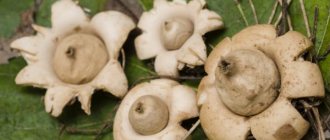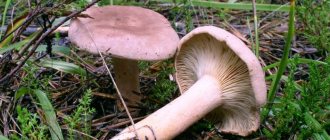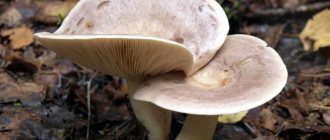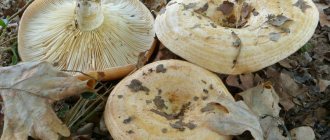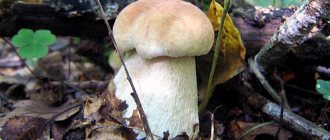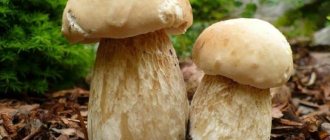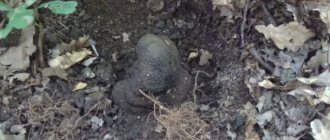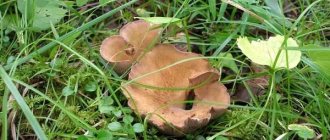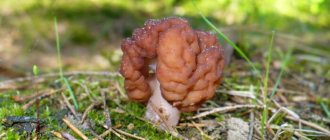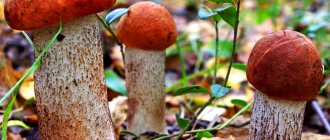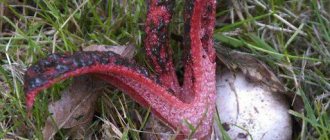Stolyarov Vasily Stepanovich
Expert in Silent Hunting
At first glance, the orange milkweed is good for everyone - it looks beautiful and the aroma of its pulp is pleasant. The only bad thing is that the hot milky juice makes it completely inedible. If you accidentally eat it, nothing particularly bad will happen. The maximum you can expect is a slight stomach upset and an inevitable bitter taste in your mouth.
— Stolyarov Vasily Stepanovich Expert in silent hunting
Milky gray-pink
| Group: | Lamellar |
| Records: | White, beige-gray-pink |
| Color: | Beige-gray-pink |
| Info: | When broken it smells like chicory |
| Department: | Basidiomycota (Basidiomycetes) |
| Sub-department: | Agaricomycotina (Agaricomycetes) |
| Class: | Agaricomycetes (Agaricomycetes) |
| Subclass: | Incertae sedis (uncertain position) |
| Order: | Russulales |
| Family: | Russulaceae (Russulaceae) |
| Genus: | Lactarius (Millary) |
| View: | Lactarius helvus (Grey-pink milky plant) |
This type of milkweed is inedible according to some sources, but conditionally edible according to others. In foreign literature it is noted as slightly poisonous; in the domestic literature - as inedible or as edible, but of little value due to the strong unpleasant odor.
hat
Grows to medium size (about 15 cm in diameter). In the middle of it, both a depression and a tuberculate outgrowth can form. As the fungus grows, both signs appear simultaneously. The edges of the cap of young mushrooms are folded downwards, and with age they open up. Its color is beige-gray-pink. The surface is not slimy, dry and velvety to the touch.
Pulp
Fleshy, pale and rather fragile. When broken or cut, the pulp smells very strongly of chicory. It tastes bitter. It produces a small amount of milky juice, the consistency of which resembles water. The juice does not change color in air.
Leg
The legs of these milkweeds are short and very stocky (about 8*2). Their color is slightly lighter than the surface of the cap. In young specimens, the legs are full, and during the process of growth they form uneven cavities inside. These lactifers do not have any additional growths on their legs; they are smooth.
Spore-bearing layer
The spore layer is made of plates. Plates of medium thickness and frequency of arrangement. The color is almost the same as the cap, but a little lighter. In very young mushrooms, the plates are almost white, then darken.
Spore powder
The spores of the gray-pink lacticifer are almost round, of medium size, with a mesh surface, the bulk of the powder is orangish-yellow.
Distribution and collection
The gray-pink milky plant is distributed throughout the northern hemisphere in temperate climates. It usually forms mycorrhizae with coniferous species such as pine or spruce, but in other conditions it can grow next to deciduous species, in particular birch. This species prefers acidic soils, which are usually found in blueberry thickets and near swamps.
Similar species
This type of milkweed has practically no counterparts due to its extremely specific smell.
But outwardly it may look like:
It features a subtle concentric pattern on the cap. In addition, the smell is different - oak milkweed smells like hay, not chicory. In general, this mushroom is smaller and grows mainly near oak trees.
This mushroom is also distinguished by its more modest size and darker color, predominantly brownish-red. Doesn't smell like chicory like the gray-pink variety.
Where do milk mushrooms grow and when are they harvested?
Milk mushrooms do not like loneliness. Mushroom families choose places near linden and birch trees. Harvest at the end of summer and autumn in deciduous or mixed forests. Mushrooms form extensive colonies in clearings where there is white clay close to the surface.
Milk mushrooms are harvested from July until the first frost. Autumn harvests are at a special price. Milk mushrooms are not bitter at this time.
Milk mushrooms form symbiotic relationships with higher plants. Root systems exchange nutrients. Most species of milk mushrooms create colonies near birch trees. A smaller number of species prefer coniferous forests. The older the tree, the higher the likelihood of finding mycelium near it.
In young forests the size of a man, milk mushrooms cannot be found. The older the forest, the higher the chance of falling on these mushrooms.
The following conditions are important for the growth of milk mushrooms:
- soil type;
- soil moisture;
- how the sun warms the soil.
Most varieties prefer sun-warmed, moderately damp places with grass, moss or a litter of rotting leaves; they do not like dry and marshy areas.
Similar species
This type of milkweed has practically no counterparts due to its extremely specific smell.
But outwardly it may look like:
It features a subtle concentric pattern on the cap. In addition, the smell is different - oak milkweed smells like hay, not chicory. In general, this mushroom is smaller and grows mainly near oak trees.
This mushroom is also distinguished by its more modest size and darker color, predominantly brownish-red. Doesn't smell like chicory like the gray-pink variety.
1- Oak milkweed 2- Bitterweed
The gray-pink lacticaria does not look like obviously poisonous mushrooms, so it cannot be confused with them.
What can be confused with
Despite its bright color, orange tremor is safe for humans, so it is easily used for cooking or in treating problems. However, there are false doubles, the consumption or preparation of which can lead to serious problems, including poisoning and causing significant harm to the body.
Given the specific external color of the mushroom, it will be quite difficult to confuse it with other mushrooms. However, it is worth considering that in the trembling family there are specimens that very much resemble their orange counterpart.
Have you heard about this mushroom?
Yes 25%
No 55%
Saw it but didn't know what it was called 20%
Voted: 20
Let's turn to the leaf shaker. This mushroom is inedible, however, in its external structure and placement, this mushroom very much reminds us of yellow brain.
However, a significant difference appears in color. Leaf shake is more of a dark orange or pale red hue. But inexperienced mushroom pickers still think that this is an orange trembler and pick it. Such a mushroom cannot cause poisoning, but it has very mediocre taste properties and will simply ruin a couple of dishes for you.
Another species that can be confused with the orange tremble is the fucus trembler. True, it is easy to distinguish by color. The fucus-shaped tremors are almost transparent, with a white undertone, as if the cloudy liquid had turned into jelly and temporarily froze in a strange shape.
However, some mushroom pickers are sure that this is nothing more than an albino from the orange tremors and continue to pick these mushrooms and put them in their basket. Meanwhile, the fucus trembler is also an inedible mushroom that actively absorbs negative substances and can lead to poisoning.
It is necessary to take the issue of collecting such mushrooms very seriously.
Description
- The diameter of the hat can reach 8 cm, but in reality the top does not grow more than 6 cm. The base height is on average about 5 cm with a width of 2 cm. There are plates on the inside of the hat. They are not too wide, but not narrow either, located close to each other, slightly lowered. The plates contain yellow colored spore powder.
- The tops of young animals protrude. However, over time they straighten out and take on a depressed format. Eventually, the mushroom cap becomes like a funnel. The upper part has an orange skin. It is smoothed, matte with a slight shine in a chaotic manner. When growing in humidity it becomes slippery.
- Leg in cylinder format. Tapers towards the bottom. In young animals it is lightened, similar in shade to a hat. When the mushroom grows and becomes mature, its base becomes empty inside. These mushrooms secrete a lot of juice, which is distinguished by its thickness. It is sticky, caustic, painted in a light tone, and does not change color when weathered. The pulp has fibers and smells like orange.
Unusual mushrooms. The most unusual representatives of the mushroom kingdom
Mushrooms can be very different in shape, size and variations in adaptability. Their number is incalculable. Therefore, we will present only the most amazing mushrooms in the world.
Lampshade mushroom Parasola plicatilis
The resemblance to a floor lamp is given to these creatures by the folded cone-shaped cap rising on a thin elegant leg. The folded dung beetle grows in large families. Having met a large family of these amazing capped mushrooms at the edge of the forest, it may seem that you find yourself in a miniature gallery of chandeliers, intended for tiny inhabitants of the underground kingdom - gnomes.
Devil's fingers Clathrus archeri
Those who see Archer's Clathrus for the first time do not immediately realize that what they are looking at is not a starfish or a lovely cactus, but a real mushroom. The young ovoid fruiting body is decorated with 3 to 8 lobes branched like tentacles. When unfolded, they form an unusual flower with star-shaped petals 10-15 cm in diameter. The “petals” emit an unpleasant odor that attracts insects.
Star mushroom Myriostoma coliforme
The unusually shaped mushroom is the only representative of the Myriostome genus. It can have a spherical or flattened cap, dotted with a scattering of small holes. Its size before opening is only 1-5 cm, and after it reaches a diameter of 6-10 cm. For such an unusual shape, Myriostoma received a second name - octopus.
Myriostoma cervicalis is extremely rare in forests. It grows in single specimens, and therefore is not easy to find.
Turkey tail Trametes versicolor
Trametes variegated, which prefers to grow sideways on wood, is interesting for its unusual coloring of the fruiting body. The flat caps, often fused with each other, are colored with variegated stripes. Their color palette is very diverse, starting with blue and silver and ending with emerald, burgundy and black. Thanks to its bright color, it is impossible to confuse it with other representatives of the mushroom kingdom. Polypores grow in small groups. They settle on stumps, logs and deciduous trees. Although colorful mushrooms are inedible, they are widely used in medicine. In Japan they are used to treat oncology, in China they are used to restore the functioning of the immune system.
Glow in the dark panellus
Panellus, whose name is translated from Latin as “cookie” or “bread”, is interesting not only for its unusual shape of the fruiting body, but also for its unique ability to bioluminesce. Its cap is initially kidney-shaped, but as it develops it becomes ear-shaped and fan-shaped. The small cap, the diameter of which is no more than 3-4 cm, is covered with dozens of tiny cracks. The luminous properties appear as a result of a chemical reaction involving oxygen and luciferin. Thanks to this, panneluses, which prefer to settle on the trunks of beech, oak and birch trees, glow with a green glow in the dark.
Useful properties, medical use and restrictions on use
Milky mushrooms have been used since ancient times in folk medicine to treat purulent wounds, kidney diseases and other diseases. Most species have antitumor and antibacterial effects. The fruit contains vitamins that have a beneficial effect on the nervous system and serve to prevent the development of sclerosis.
Gruzd
Medicines made from milk mushrooms help cope with kidney stones. Blue mushroom contains a natural antibiotic that has a detrimental effect on staphylococci. Scientists have discovered lactarioviolin in some fruits, an antibiotic that helps destroy tuberculosis pathogens.
Most mushrooms of this genus are conditionally edible fruits, so they need heat treatment before consumption. You cannot harvest crops near highways, factories and factories; it is better to do this in environmentally friendly areas. It is not recommended to eat these fruits if you have gastrointestinal diseases, pregnancy or breastfeeding.
Recipes and cooking features
Mushrooms of this kind can be fried, boiled and pickled, but in this form their taste is muted. Salted and fermented milkweeds are characterized by good taste. Saffron milk caps do not require long-term soaking, but bitter mushrooms, milk mushrooms and milk mushrooms should be soaked for some time in cold water.
Here are some delicious recipes:
- If the basket is filled with saffron milk caps, this is an excellent reason to please your loved ones with fried mushrooms.
The harvest is washed and cleared of forest debris. Each specimen is cut into 5-7 parts and placed in a heated frying pan with sunflower oil. Fried saffron milk caps The heat should be medium so that the water from the mushroom mass evaporates faster. When the water boils, reduce the heat and fry for about 15 minutes. At this time, you can add finely chopped onion, salt and fry for about five more minutes. - To prepare delicious mushrooms in Korean, you will need the following ingredients:
- lacticaria (any bitter mushrooms);
sugar;
soy sauce; table vinegar; fresh garlic; hot pepper; ground coriander.
Milkmen in Korean
The fruits are pre-boiled 2-3 times for 30 minutes, changing the water each time. It is desirable that they retain a slightly bitter taste, which will give the dish a special piquancy. Boiled fruits are seasoned with soy sauce, sugar is poured in and a little vinegar is poured in. The resulting mass is thoroughly mixed with the addition of the necessary spices. The finished dish should be allowed to brew for several hours in the refrigerator.
Lubyanka mushroom. What mushrooms can you eat without harm to your health? List of edible mushrooms
Knowledge about edible mushrooms will be useful to every mushroom picker. Edible mushrooms include those mushrooms that are safe to eat and do not require special preparation. Edible mushrooms are divided into several types, the most famous of them: tubular, lamellar and marsupial. You can read more about edible mushrooms in this article.
Signs
Edible mushrooms are mushrooms that do not require special processing and can be cooked and eaten immediately. Edible mushrooms do not contain any toxic substances that can harm the body; they are absolutely safe for humans.
The nutritional value of edible mushrooms falls into four categories, from high-grade to low-grade mushrooms.
In order to distinguish edible mushrooms from inedible ones, you need to know some common distinguishing features:
edible mushrooms do not have a specific pungent odor; the color of edible mushrooms is less bright and catchy; edible mushrooms usually do not change color after the cap is cut or broken; the flesh may darken when cooked or broken; In edible mushrooms, the plates are attached to the stem more firmly than in inedible ones.
All these signs are conditional and do not provide an exact guarantee that the mushroom is edible.
On video
clearly shows how to distinguish edible mushrooms from poisonous ones using the example of the most common mushrooms. It also tells you what to do in case of poisoning:
Conditionally edible
In addition to edible ones, there are also conditionally edible mushrooms. They are classified in a separate category because they produce a bitter juice or contain poison in very small quantities.
Such mushrooms must be subjected to special processing before cooking, namely:
- soak (from 4 to 7 days);
- boil (15-30 minutes);
- scald with boiling water;
- dry;
- salt (50-70 g of salt per 1 liter of water).
Among conditionally edible mushrooms, even with special processing, it is recommended to consume only young specimens, without signs of aging or rotting.
Some mushrooms may only be inedible if eaten with other foods. For example, dung beetle is not compatible with alcohol.
Tubular
Tubular mushrooms are distinguished by the structure of their cap, which has a porous structure resembling a sponge. The inner part is permeated with a large number of small tubes intertwined with each other. Mushrooms of this type can usually be found in the shade of trees, where there is little sunlight, damp and cool.
Among tubular mushrooms, both edible and conditionally edible ones are common. Their fruits are very fleshy and have high nutritional value.
Among the edible tubular mushrooms there are many poisonous look-alikes. For example, a safe porcini mushroom can be confused with an inedible gall mushroom. Before picking, you should carefully study the characteristics of edible fruits.
Useful properties of milkweeds
Mushrooms of the genus lacticaria have served as food for people in many countries of the world for a long time, especially in the northern regions of Eurasia. They are famous for their medicinal and preventive properties:
- Many species of these mushrooms are valuable for the antibiotics they contain.
- B vitamins found in mushrooms have a beneficial effect on the human nervous system and help resist the development of sclerosis.
- Medicines made from milk mushrooms help with kidney stones. For example, blue milk mushroom (dog) contains antibacterial substances that can kill staphylococci. Russian folk healers used milk mushrooms to treat kidney diseases, purulent wounds and other ailments.
Calorie content of fresh milk mushrooms: 100 grams of mushrooms contain 16 kcal. This volume of mushrooms contains the following substances:
- 88 g water;
- 1.8 g protein;
- 0.8 g fat;
- 0.5 g carbohydrates;
- 1.5 g fiber;
- 0.4 g ash;
- Vitamins B1, B2, C, PP;
- Amino acids tyrosine, glutamine, arginine, leucine.
100 grams of fresh volushki contain 22 kcal. This amount of mushrooms contains:
- 92.31 g water;
- 3.09 g protein;
- 0.34 g fat;
- 3.26 g carbohydrates;
- 1 g fiber;
- vitamins: C, B1, B2, PP, B5, B6, B9, B12, E, D, D2, K1;
- minerals: selenium, calcium, magnesium, iron, potassium, sodium, phosphorus, zinc, copper, manganese;
- choline, betaine.
Calorie content of saffron milk caps: 100 grams of fresh mushrooms – 17 kcal. Camelina contains:
- 88.9 g water;
- 2.9 g protein;
- 0.8 g fat;
- 2 g carbohydrates;
- 2.2 g dietary fiber;
- 0.7 g ash;
- Vitamins: B1, B2, C, PP, beta-carotene. By the way, the orange color of mushrooms is precisely explained by the high content of beta-carotenes;
- Minerals: magnesium, phosphorus, potassium, iron, sodium, calcium;
- The antibiotic substance lactriovioline suppresses the development of most bacteria, including tuberculosis bacillus. This antibiotic was isolated from red camelina.
Calorie content of bitters: per 100 g of fresh mushrooms – 22 kcal. The mushroom is rich in useful substances, it contains:
- 92.45 g water;
- From 2.18 to 3.09 g of protein;
- 0.34 g fat;
- 3.26 g carbohydrates;
- 1 g fiber;
- vitamins: C, B1, B2, B3, B5, B6, B12, E, D, K;
- minerals: potassium, magnesium, phosphorus, iron, calcium, sodium, zinc, manganese, copper, selenium;
- choline, folates;
- antibiotic that kills Staphylococcus aureus.
The milk mushrooms are yellow.
Direct salting
So, you have fully prepared molokan mushrooms. How to salt is a separate song, although not too difficult to perform. In the absence of a tub, it is recommended to use an enamel bucket without chips on the inner surface.
Large caps can be cut - purely for ease of use. The mushrooms are layered with halved garlic (about a head will be left), thin circles of horseradish root, lemongrass and black currant leaves, dill seeds (or its umbrellas). Black peppercorns are also acceptable, but not too much. Each layer is sprinkled with a coffee spoon of salt. The top of the bucket is covered with clean gauze, a wide plate and a weight are placed on it - a three-liter bottle of water will be enough. Monitor the condition vigilantly: if mold forms on the gauze, it must be washed. It’s better to replace it with a new one, it’s not that expensive.
Molokankas will be salted from a couple of weeks to a month, depending on the temperature. The warmer the faster, the colder the tastier. It is better to store them cool and eat them like any other salted mushrooms.
Description
This mushroom is somewhat similar in structure to bittersweet, but differs from it in its lighter color.
hat
Grows to medium size (about 15 cm in diameter). In the middle of it, both a depression and a tuberculate outgrowth can form. As the fungus grows, both signs appear simultaneously.
The edges of the cap of young mushrooms are folded downwards, and with age they open up. Its color is beige-gray-pink. The surface is not slimy, dry and velvety to the touch.
Pulp
Fleshy, pale and rather fragile. When broken or cut, the pulp smells very strongly of chicory. It tastes bitter. It produces a small amount of milky juice, the consistency of which resembles water. The juice does not change color in air.
Leg
The legs of these milkweeds are short and very stocky (about 8*2). Their color is slightly lighter than the surface of the cap. In young specimens, the legs are full, and during the process of growth they form uneven cavities inside. These lactifers do not have any additional growths on their legs; they are smooth.
Spore-bearing layer
The spore layer is made of plates. Plates of medium thickness and frequency of arrangement. The color is almost the same as the cap, but a little lighter. In very young mushrooms, the plates are almost white, then darken.
Spore powder
The spores of the gray-pink lacticifer are almost round, of medium size, with a mesh surface, the bulk of the powder is orangish-yellow.
Ecology
All members of the genus are obligate fungi and are found in various types of forests around the world. There are both species that are non-specific with respect to plant symbionts, as well as genus-specific ones—forming mycorrhizae with several closely related plant species. So, L. quietus
enters into symbiosis only with plants of the oak genus,
L. glyciosmus
with birches, and
L. deterrimus
with spruce trees.
Nonspecific mycorrhiza-formers in different natural zones also exhibit a certain genus specificity. Thus, the widespread Holarctic species L. rufus
in southern Karelia is found mainly in pine forests on dry sandy soils, and on the Kola Peninsula - in spruce forests. In the south of Western Siberia, the same species does not show any particular genus specificity and is found with approximately the same frequency in different types of forests.
Poisonous and inedible types of laticifer mushroom
Sticky milkweed (Lactarius blennius)
Inedible mushroom.
The diameter of the cap is 4-10 cm, the shape is convex, later spread out, the edge is curved. The surface of the cap is shiny, sticky, gray-green in color with dark concentric zones. The leg is 4-6 cm long, 2.5 cm in diameter, light. The pulp is white, odorless, the taste is sharp, peppery. The milky juice is thick and white.
Mycorrhiza forms with deciduous trees and grows in summer and autumn in small groups in deciduous forests of Europe and Asia.
Gray-pink milkweed (Lactarius helvus)
Inedible mushroom.
The cap is 6-12 cm in diameter, the shape is flat, later funnel-shaped, the edge is curled. The color is pinkish-brown. The stem is 9 cm high, 1.5-2 cm thick, cylindrical in shape, the color matches the cap. The pulp is light yellow. The smell is strong, spicy, unpleasant. The taste is bitter. The milky juice is watery-white.
Grows in coniferous forests in the northern temperate zone. Fruiting season is from July to September.
Liver milkweed (Lactarius hepaticus)
Inedible mushroom.
The cap is 3-6 cm in diameter, the color is liver-brown, the surface is smooth. The stem is 3-6 cm in height, 0.6-1 cm in thickness, cylindrical in shape, color like a cap. The pulp is thin, cream or light brown, acrid.
Mycorrhiza forms with pine.
Dark milky (Lactarius obscuratus)
Inedible mushroom.
The cap is 1.5-3 cm in diameter, the young mushroom is flat, later goblet-shaped, the edge is wrinkled, the surface is matte, the color is ocher-brown. The stem is 0.5 cm in diameter, 2-3 cm high, cylindrical in shape, color like a cap. The pulp is brittle and brown. The milky juice is white.
Grows in mixed and deciduous forests, from mid-July to September.
Resin-black milky plant (Lactarius picinus)
Inedible mushroom.
The cap is 4-10 cm in diameter, convex in shape, later spread out. The surface is velvety, brownish-brown. The stem is 3-6 cm high, 1-1.5 cm thick, cylindrical in shape, tapering towards the base. The pulp is white, dense, the smell is weak, fruity, the taste is sharp, peppery, turns pink in the air. The milky juice is thick, white, and turns red in air.
Grows in small groups or singly in coniferous and mixed forests. The season starts in mid-August and lasts until the end of September.
Orange Milkweed (Lactarius porninsis)
Inedible mushroom.
The hat is 3-8 cm in diameter, convex in shape. Orange color, smooth surface.
The stem is 3-6 cm long, 0.8-1.5 cm in diameter, cylindrical in shape, tapering towards the base; in a young mushroom it is solid, later hollow, the color matches the cap. The pulp is dense, fibrous, the smell is orange. The milky juice is thick, sticky, and white.
Grows in deciduous forests, in small groups, in summer and autumn.
Wet milkweed (Lactarius úvidus)
Inedible mushroom.
The diameter of the cap is 4-8 cm; the young mushroom has a convex shape, later spread out. The edge is folded. The color is steel-gray with a violet tint, the surface is smooth and moist. The pulp is odorless, has a pungent taste, white or yellowish, and turns purple when cut. The milky juice is abundant, white, and turns purple in air. The leg is 4-7 cm high, 1-2 cm thick, strong, cylindrical.
A rare mushroom that grows in damp deciduous and mixed forests from early August to late September.
Growth
- Fruiting bodies prefer to live in larches. They can be found growing in splendid isolation or in small groups. Fruiting begins in summer and ends in autumn. Mycorrhiza forms with deciduous trees.
- This variety is classified as inedible. Moreover, according to some mycologists, orange members of the family are considered even mildly poisonous. There is no danger to life, but consumption leads to disorders of the gastrointestinal tract.
Evaluation of taste qualities and recipes for preparing oak milkweed
Like other milkweeds, oak is primarily used for salting and pickling. Long-term soaking, as well as the use of vinegar in preparation, allows you to neutralize a special toxic substance contained in these mushrooms - lactarins. An alternative method to protect yourself from possible illnesses after eating oak milkweed is heat treatment (boiling). These measures not only increase the edibility of the mushroom, but also improve its taste.
Primary processing
The traditional way to prepare mushrooms for pickling and pickling is to soak them in cold water. The fruiting bodies, previously cleared of dirt and damaged areas, are filled with water and pressed down with a plate with a weight so that the mushrooms do not float. The duration of the procedure is at least 24 hours (ideally 2–3 days). To avoid acidification, it is recommended to change the water every 10–12 hours; if the room temperature is high, then more often.
Cooking
It is an alternative method of primary processing of oak laticifer. Cleaned mushrooms are boiled in boiling salted water for 15–20 minutes. After that, they are thrown into a colander and washed under running water.
Frying
Not everyone will dare to undertake such a culinary experiment, but theoretically you can prepare a roast from pre-soaked or boiled milkweed. To improve the taste, you can add onions, garlic and potatoes.
Pickling
Mushrooms are laid out on the bottom of a non-metallic dish in layers sprinkled with salt. Many housewives add bay leaves and black peppercorns for taste. A pressure is placed on top of the mushrooms, and the workpiece itself is sent to a cool, shaded place. After 7–10 days, you can put the pickles into jars, but they will be ready for use only after a month.
Drying
Like any lamellar mushroom, oak lacticaria is rarely dried for the winter, since with this method of processing very little of the final product comes out.
For drying, use special electric dryers or ovens. Place the cut mushrooms on a wire rack so that they do not touch each other. Set the temperature to about 50 degrees, preferably with convection mode. Readiness is determined by the properties of the processed mushrooms - they should be fairly dry, but elastic.
How to view Rothko's paintings?
Numerous reviews from eyewitnesses say that the paintings of the American abstract artist are capable of literally absorbing the viewer, creating the feeling that you are standing in front of a portal into which you will inadvertently fall through and emerge in another dimension. By the way, you can feel a significant difference if you look at the artist’s works, at least on videos that capture his exhibitions in museums or art galleries. The video frames show more clearly the nuances of applying paints to the canvas, the degree of their density/transparency, and mixing layers at the boundaries of rectangles. Photographs do not convey the glow emanating from some paintings, while the effectiveness of others is greatly enhanced by the conditions in which they are exhibited and the combination with neighboring paintings and lighting.
By the way, the artist himself attached great importance to these factors. He could easily refuse an offer to present his paintings in a prestigious gallery if he was not guaranteed that all his requirements would be met. And while participating in the “15 Americans” exhibition, Rothko kept turning off several light sources in the room where his works were exhibited. This did not help much: as soon as the artist left the gallery, the curator turned them on again, appealing to the fact that otherwise it would be too dim and gloomy.
Features of care
- The tailed poultry plant is calm about watering, although it is recommended to regularly moisten the soil during the growth period. It feels great on any soil. But if there is not enough light, it will definitely die.
- In summer, plants are moved to the balcony. It is better to grow poultry grass on the plot, since it does not form seeds at home.
- During plant growth, fertilizing with nitrogenous fertilizers should be carried out. After the bulbs and leaves have formed, you can feed the poultry plant with fertilizers for flowering plants.
- The plant tolerates winter well. There is no need to cover it. If you leave your poultry plant in pots at home in winter, remove it from heat sources - radiators. Watering for the winter must be reduced. At the same time, you should make sure that the soil does not dry out completely.
- Dead leaves must be carefully removed. If the leaf has not completely withered, it is better not to touch it, as this may harm the plant.
- During flowering and boll formation, watering should be reduced.
- There is no need to spray; you can simply wipe the leaves with a cloth.
- Thinning of plants in open ground should be carried out every 4 years.
Precautionary measures.
As mentioned above, it is very difficult to confuse lacticaria with any other type of toxic mushroom. It is slightly similar in appearance to the silverback, but science does not know any dangerous, poisonous counterparts. Therefore, knowing the main external differences, it is almost impossible to confuse the milkweed with some dangerous mushroom
We must also not forget about standard precautions that do not apply only to this type of mushroom
There is a golden rule that applies to even the most experienced mushroom pickers: “If you’re not sure, don’t cut!” If you adhere to this rule, the risk of poisoning will decrease tenfold. And of course, we should not forget about the amazing ability of mushrooms to accumulate toxic substances and heavy metals if they grow in an unfavorable, polluted area.
Literature
- "Funghi", - Instituto Geografico De Agostini, Novara, Italy, 1997
- Garibova L.V., Sidorova I.I. Mushrooms. Encyclopedia of Russian nature. - M.: 1999.
- F.V. Fedorov, Mushrooms. — M., Rosagropromizdat
- Gorlenko M.V. et al. Mushrooms of the USSR. - M.: 1980
- Bulakh E.M.
Lower plants, fungi and bryophytes of the Soviet Far East. Mushrooms.. - L.: Nauka, 1990. - T. 1. - P. 13-55. — 407 p. — ISBN 5-02-026578-0. - Gorovoy L.F.
Morphogenesis of lamellar fungi. - Kyiv: Naukova Dumka, 1990. - 166 p. — ISBN 5-12-000791-0. - Perova N.V., Gorbunova I.A.
Macromycetes of the south of Western Siberia. - Novosibirsk: Publishing house SB RAS, 2001. - 158 p. — ISBN 5-7692-0460-5. - Shaporova Y. A.
Russular mushrooms of Belarus: Lactarius and Russula (lacticaria and russula). - Minsk: Belarusian Science, 2007. - 275 p. — ISBN 978-985-08-0814-1. - Shubin V.I.
Mycorrhizal fungi of the North-West of the European part of the USSR. (Ecological characteristics). - Petrozavodsk: Karelian Branch of the USSR Academy of Sciences, 1988. - 216 p. - Basso MT
Fungi Europaei. - Alassio, Italy: Massimo Candusso, 1999. - Vol. 7 Lactarius Pers. — 844 p. — ISBN 88-87740-00-3. - Bessette A., Bessette AR, Harris DB
Milk Mushrooms of North America. - Syracuse, USA: Syracuse University Press, 2009. - 299 p. — ISBN 0-8156-3229-0. - Funga Nordica / Editors Knudsen H., Vesterholt J.. - Copenhagen, Denmark: Nordsvamp, 2008. - 965 p. — ISBN 978-87-983961-3-0.
- Heilmann-Clausen J., Verbeken A., Vesterholt J.
Fungi of Northern Europe. - Odense, Denmark: Skive Offset, 1998. - Vol. 2: The genus Lactarius. — 288 p. — ISBN 87-983581-4-6. - Kränzlin F.
Fungi of Switzerland. - Luzern, Switzerland: Verlag Mykologia, 2005. - Vol. 6 Russulaceae. — 318 p. — ISBN 3-85604-260-1. - Rayner RW
British fungus flora. Agarics and Boleti. - Oxford, UK: Alden Press LTD, 2005. - Vol. 9 / Russulaceae: Lactarius. — 318 p. — ISBN 1-872291-34-1.
